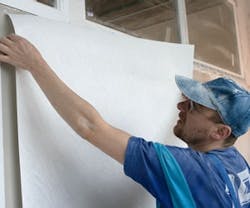Eco-friendly has become more than a trend – it has become a revolution and has staying power. As new eco-friendly products are emerging every day, it may be difficult to determine which products are viable options that are worth your money and which products you should just pass by. Eco-friendly wallcoverings, while once expensive and in limited availability, are now widely available in a wide variety of patterns and materials, and for the cost-conscious.
"Over the years, wall finishes have gone from an aesthetic element to brighten and decorate a room to a finish that serves as more of a functional element," says Dan Brandt, product manager at MDC Wallcoverings. "Whether a space demands an aesthetic touch or a functional one, one thing is for certain, the need for eco-friendly finishes is a growing trend."
As with most trends, there are different definitions and categories. Eco-friendly wallcoverings generally fit into three categories: products made with renewable/natural content; products made with recycled content that are recyclable; and products with low VOCs that meet indoor air quality requirements. This second option – products that are manufactured with recycled content that can be reclaimed at the end of life for secondary use (cradle-to-cradle) – is a growing trend.
Break Tradition
Traditional wallpapers are commercial vinyl and are PVC based. They are a durable, long lasting product. However, they are not necessarily environmentally friendly. "Anything with polyvinyl chloride (PVC) is considered a negative in the environmental area," explains LeRue Brown, director of marketing at York Wallcoverings. "It's not a recyclable product, but the life cycle of the product in the building is very long – which is why it's been a staple in the commercial building trade." Type II wallcoverings are often used in non-residential environments, as they are medium-duty and are considered to be durable and useful in high-traffic environments where surface abrasion is expected.
While there are several "no compromise" alternatives to commercial vinyl, they may not be true equals. "We have a product that meets a lot of the Type II standards," says Brown. "If you're familiar with commercial vinyl, that's what people use as the standard for putting it in buildings because it meets flame tests, scrubbability and durability tests, tensile strength, and such. We have a nonwoven product that is paper-based with some polyester fibers to give it strength. It's very breathable and it meets a lot of the Type II standards – but for tear strength and some of the others, it doesn't really meet it."
Considerations
This doesn't mean that you should stay away from eco-friendly wallcoverings completely. Rather, you should think about location and traffic. "If you have it in an area where you're pushing hospital carts into it or other things like that, it's probably not going to be as durable as commercial vinyl," says Brown. "Our paper wallcovering products have an acrylic coating and are pretty durable. They're probably over-engineered for most areas."
"Vinyls have been the workhorse of the industry," adds Brandt. "Natural products have traditionally been used in areas of low to moderate abuse. A facility manager/building owner must always consider the area of use and maintenance required prior to selecting a product. If the product is not going to perform, then selecting an eco-friendly product will not be in the best interest of the client/space."
While eco-friendly wallcoverings may not stand up to commercial vinyl wallcoverings when it comes to durability, they do best traditional commercial vinyl in one attribute: breathability. "Vinyl isn't impenetrable; it doesn't breathe as well as other products," explains Brown. "The vinyl can trap moisture if there's a moisture problem in the wall." As many eco-friendly products are porous, they may offer better breathability than vinyl. "One of the advantages is it is a more breathable product. If you have a building that has a problem with moisture, particularly in some of the humid areas of the South, that's probably an advantage."
Looking Towards the Future
"The movement towards eco-friendly products has shifted considerably in recent years. Our responsibility extends from materials selected, improved manufacturing processes, and end of life options. There has been a significant increase in the use of recycled material: both post-consumer and post-industrial. The industry has adopted reclamation practices to offer end of life options for previously discarded materials. It is critical that we maximize the use of materials that can be replenished," concludes Brandt. "The green movement will continue to dominate the market, so we expect technological advancements in the development of new materials."
Kylie Wroblaski ([email protected]) is associate editor
of BUILDINGS.
